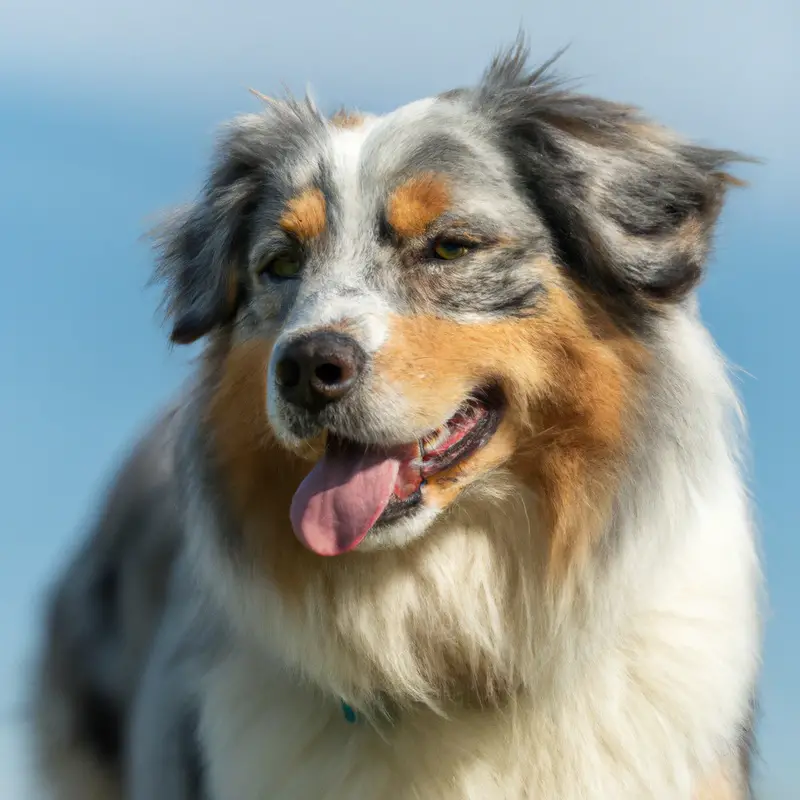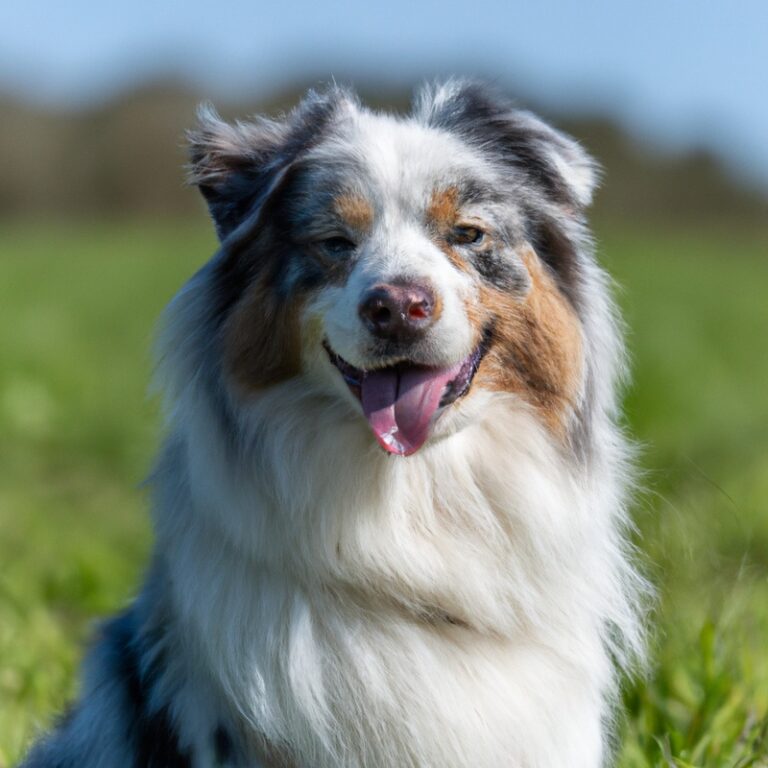What Kind Of Collar Or Harness Is Best For An Australian Shepherd?
Key Takeaways:
- A martingale collar or a back-clip harness may be the best options for an Australian Shepherd.
- Collars or harnesses that distribute pressure evenly are ideal for Australian Shepherds.
- It is important to choose a collar or harness that fits properly to ensure comfort and safety for an Australian Shepherd.
- Personal preference and individual needs should also be considered when choosing a collar or harness for an Australian Shepherd.
Do you find yourself grappling with the age-old question of which collar or harness is best for your beloved Australian Shepherd? Well, fret no more, because I’m here to unravel the mystery and guide you towards the perfect choice! As a passionate dog enthusiast and experienced Australian Shepherd owner, I’ve navigated the world of collars and harnesses to discover what truly works for our lively and energetic friends.
In this article, we’ll explore the unique characteristics and exercise requirements of Australian Shepherds, delve into the different types of collars and harnesses available, discuss crucial factors to consider while making a selection, and ultimately, help you make an informed decision that benefits both you and your furry companion.
So, let’s strap in and embark on this exciting journey together!
| Collar or Harness Type | Description | Pros | Cons |
| Flat Collar | Standard collar made of fabric or leather. | – Easy to put on and take off – Variety of designs and colors – Inexpensive | – Can put strain on the neck if the dog pulls – May not be suitable for dogs with respiratory issues |
| Martingale Collar | Collar with an additional loop that tightens when the dog pulls. | – Provides better control – Prevents dogs from slipping out of the collar – Less likely to put strain on the neck | – Can be uncomfortable if fitted incorrectly – Limited control compared to a harness |
| Front-Clip Harness | Harness that has the leash attachment in the front of the chest. | – Reduces pulling by redirecting dog’s attention – Provides better control – Does not put strain on the neck | – May rub against the armpits if not properly fitted – Can be difficult to put on and adjust |
| Back-Clip Harness | Harness that has the leash attachment on the back. | – Easy to put on and adjust – Provides good control for dogs that don’t pull excessively – Does not put strain on the neck | – Can encourage pulling in some dogs – Not ideal for dogs that pull a lot |
Understanding the Needs of an Australian Shepherd
Characteristics of an Australian Shepherd
Australian Shepherds are energetic and intelligent dogs that require mental and physical stimulation. They are known for their agility and herding abilities, making them highly active and playful.
Australian Shepherds have a dense double coat that requires regular grooming to prevent matting and keep them comfortable.
They are also known for their loyalty and protective nature, making them great family pets. However, their high energy levels and strong herding instincts mean that they need plenty of exercise and mental stimulation to prevent boredom and destructive behavior.
Australian Shepherds are quick learners and thrive in an environment where they are given plenty of opportunities to engage their minds and bodies.
They are highly adaptable and can thrive in a variety of living situations, as long as their exercise and mental needs are met. Whether they’re running and playing in a spacious yard or participating in dog sports and training, Australian Shepherds excel when given a job to do.
Understanding their characteristics and needs can help you provide the best care and create a strong bond with your Australian Shepherd.

Activity Levels and Exercise Requirements
Australian Shepherds are highly energetic dogs that require plenty of exercise to stay happy and healthy. They have high activity levels and exercise requirements, making them unsuitable for those who prefer a more laid-back lifestyle.
These dogs thrive in active households where they can engage in regular physical activities like running, hiking, and playing fetch.
Daily exercise is essential for Australian Shepherds to prevent boredom and help them release their pent-up energy. They require at least an hour of vigorous exercise each day.
This could include activities such as brisk walks, jogging, or participating in dog sports like agility or obedience training.
Mental stimulation is also crucial for these intelligent and highly trainable dogs, so incorporating puzzle toys or obedience training sessions can provide a great mental workout. It’s important to note that Australian Shepherds are natural herders and may exhibit behaviors like nipping or chasing after children or other animals.
Proper exercise and training can help channel their energy in a positive way and prevent them from engaging in undesirable behaviors.
Moreover, dog owners also need to ensure that they provide a safe and secure environment for their Australian Shepherds to exercise, whether it’s a securely fenced yard or a leash and harness during walks. Incorporating regular exercise into a daily routine is not only beneficial for the physical health of Australian Shepherds, but it also helps to keep them mentally stimulated and prevents behavioral issues.
Owners of Australian Shepherds should strive to meet their exercise requirements to ensure they remain happy and well-balanced companions.
By providing appropriate physical and mental stimulation, owners can help address the breed’s high activity levels and exercise needs.
Different Types of Collars for Australian Shepherds
Traditional Flat Collars
Traditional flat collars are one of the most common and basic options for Australian Shepherds. These collars are simple and consist of a flat strip of material with a buckle or clip for fastening.
They are typically made of nylon or leather and come in various colors and sizes to suit your dog’s needs.
One of the advantages of traditional flat collars is their ease of use. They are simple to put on and take off, making them convenient for walks and everyday use.
They also provide a place to attach identification tags and a leash for walks.
However, it’s important to keep in mind that traditional flat collars can put pressure on a dog’s neck if they pull or lunge while on a leash. This could potentially lead to discomfort or injury, especially if your Australian Shepherd tends to pull a lot.
To ensure the safety and comfort of your Australian Shepherd, it’s crucial to choose the right size and fit for their collar.
A properly fitted flat collar should be snug enough that it can’t slip over their head, but loose enough that you can fit two fingers between the collar and their neck. While traditional flat collars can be suitable for Australian Shepherds, it’s also important to consider other options, such as martingale collars or head halters, that can provide additional control and prevent neck strain.
Consulting with experienced owners or trainers can help you make an informed decision on the best collar for your dog’s specific needs.
Martingale Collars
Martingale collars are a popular option for Australian Shepherds. These collars are designed to provide gentle control without choking or causing discomfort.
They consist of a loop that tightens when the dog pulls, preventing them from slipping out of the collar.
One of the benefits of Martingale collars is that they are effective for dogs with narrow heads, like Australian Shepherds. These dogs often have a tendency to slip out of traditional flat collars, but the Martingale collar’s design prevents this.
Another advantage of Martingale collars is that they are more comfortable for dogs than choke collars.
The Martingale collar tightens just enough to prevent escape, but does not squeeze or choke the dog. This makes it a safer and more humane option for leash training.
Martingale collars also provide an added layer of security during walks.
Even if your Australian Shepherd gets overly excited and lunges, the collar will prevent them from slipping away. This can give you peace of mind and enhance your control over the dog during walks.
When choosing a Martingale collar for your Australian Shepherd, be sure to select the correct size.
The collar should fit snugly around the dog’s neck when it is relaxed, but not be too tight or uncomfortable. Additionally, look for a collar made of durable materials that can withstand the dog’s activities.
Overall, Martingale collars can be a great option for Australian Shepherds, providing both control and comfort.
However, it’s important to remember that every dog is different, so it’s always a good idea to consult with experienced owners or trainers to find the best collar for your individual dog.

Head Halters
Head Halters are a type of collar that can be a useful tool for managing a strong-willed or reactive Australian Shepherd. They consist of a strap that fits around the dog’s muzzle, with another strap that goes behind the head.
The leash is attached to the ring on the muzzle strap, which gives the handler more control over the dog’s movements.
Some benefits of using a head halter include:
- Control: Head halters give you more control over your Australian Shepherd’s movements by redirecting their attention and gently guiding their head. This can be especially helpful for dogs who have a tendency to pull or lunge.
- Training Aid: Head halters can be a valuable training aid, helping to teach your Australian Shepherd to walk politely on a leash. By using gentle pressure to redirect their focus, you can reinforce good leash manners and discourage unwanted behaviors.
- Safety: Head halters can help prevent injuries caused by pulling or sudden movements. They reduce strain on your dog’s neck and can prevent neck and spine injuries that can occur with traditional collars.
It’s important to note that head halters should be used with care and proper training. Some dogs may initially resist wearing the halter, so it’s crucial to introduce it gradually and in a positive manner.
Always consult with a professional trainer or behaviorist to ensure you are using the head halter correctly and effectively.
While head halters can be a valuable tool, they are not suitable for every dog. It’s essential to consider your Australian Shepherd’s individual needs, behavior, and comfort level before deciding if a head halter is the right choice.
It’s also worth noting that some dogs may take some time to adjust to the head halter, so patience and consistency are key.
Overall, head halters can be valuable tools for training and managing strong-willed Australian Shepherds. When used correctly and with proper training, they can provide better control, enhance safety, and make walks more enjoyable for both you and your furry friend.
Harness Options for Australian Shepherds
Back-Clip Harnesses
Back-clip harnesses are a popular choice for Australian Shepherds. These harnesses have the leash attachment point located on the back, which provides a comfortable fit for your dog.
One advantage of back-clip harnesses is that they distribute the pulling force across your dog’s chest and shoulders, reducing strain on the neck.
This can be beneficial for dogs that tend to pull on the leash. Back-clip harnesses are also easy to put on and adjust, making them a convenient option.
They typically have multiple adjustment points to ensure a secure and snug fit for your Australian Shepherd.
Another benefit of back-clip harnesses is that they allow for better control and steering during walks. The attachment point on the back allows you to guide your dog’s movements and discourage pulling behavior.
However, it’s important to note that back-clip harnesses may not be the best option for dogs with a strong pulling instinct or those that require additional control.
In such cases, other types of harnesses, such as front-clip or no-pull harnesses, may be more suitable.
Front-Clip Harnesses
Front-clip harnesses are a popular choice for Australian Shepherds because they offer greater control and reduce pulling during walks. These harnesses have a D-ring attachment on the front, which redirects the pulling force to the side, making it easier to control your dog’s movements.
The front-clip design also helps discourage pulling by gently turning your dog’s body towards you when they pull, encouraging them to stay by your side.
This can be particularly beneficial for Australian Shepherds, who have a tendency to pull due to their herding instincts. When using a front-clip harness, it’s important to ensure proper fitting for optimal comfort.
The harness should be snug, but not too tight, and allow for your dog to move freely.
In terms of durability, look for a harness made from high-quality materials that can withstand your Australian Shepherd’s activity level. As with any training tool, it’s important to remember that a harness is not a substitute for proper training.
Using positive reinforcement methods and consistent training will help your Australian Shepherd learn to walk on a loose leash and behave appropriately during walks.
No-Pull Harnesses
No-Pull harnesses are a popular choice for Australian Shepherds and other breeds that have a tendency to pull on the leash. These harnesses are designed to discourage pulling behavior by distributing the pressure evenly across the dog’s chest, instead of their neck.
This helps to prevent choking and discomfort for your dog, while giving you better control and stability during walks.
One type of No-Pull harness is the front-clip harness, which has a D-ring attachment on the front of the chest strap. When the dog pulls, the harness redirects their forward motion, making it harder for them to continue pulling.
This type of harness is great for dogs that are still in the process of learning leash manners.
Another option is the back-clip harness, which has the D-ring attachment on the back. While it doesn’t provide as much control as a front-clip harness, it can still help to reduce pulling and is more comfortable for some dogs.
This type of harness is suitable for dogs that have already mastered leash walking and only need a gentle reminder.
When choosing a No-Pull harness, it’s important to consider the size and fit. Look for a harness that is adjustable and offers a secure fit without being too tight or restrictive.
Comfort and durability are also key factors to consider.
You want a harness that is made of high-quality materials and won’t cause discomfort or chafing for your dog. Remember, using a No-Pull harness is just one part of the equation.
You should also focus on training and reinforcing positive leash behaviors.
With consistency and patience, you can teach your Australian Shepherd to walk politely on a leash, making your walks more enjoyable for both of you.

Factors to Consider When Choosing a Collar or Harness
Size and Fit
Size and fit are essential considerations when choosing a collar or harness for your Australian Shepherd. Getting the right size ensures that the collar or harness is secure and comfortable for your dog.
A collar that is too tight can cause discomfort or restrict breathing, while one that’s too loose may slip off.
Similarly, an ill-fitting harness may chafe or impede your dog’s movement. To determine the right size, measure your Australian Shepherd’s neck circumference for a collar and their chest circumference for a harness.
Use a flexible tape measure or a piece of string to measure, and then compare the measurements to the sizing charts provided by the manufacturer.
It’s important to follow the manufacturer’s guidelines, as sizing can vary between brands. Keep in mind that Australian Shepherds are medium-sized dogs, so be cautious when selecting a collar or harness based on their weight alone.
It’s best to use both the weight and the measurements to ensure proper sizing.
Additionally, consider adjustable collars and harnesses that can be customized for a better fit. Remember, a collar or harness that fits well is essential for the comfort and safety of your Australian Shepherd.
Take the time to measure correctly and refer to sizing charts to find the perfect size for your furry friend.
Comfort and Durability
When choosing a collar or harness for your Australian Shepherd, considering both comfort and durability is important. Comfort ensures that your dog can wear the collar or harness without any discomfort or irritation.
Look for materials that are soft and hypoallergenic.
Durable options, on the other hand, will be able to withstand your dog’s daily activities and won’t break or tear easily. Consider collars or harnesses made from sturdy materials like nylon or leather.
By prioritizing comfort and durability, you can ensure that your Australian Shepherd is happy and safe during walks and activities.
Training Goals and Handling Abilities
When considering the best collar or harness for your Australian Shepherd, it’s important to take your training goals and handling abilities into account. Think about what you hope to achieve through training and how you plan to handle your dog during walks and other activities.
Training goals can vary from basic obedience to more specialized tasks, such as agility or herding.
Depending on your goals, certain collars or harnesses may be more suitable. For example, if you’re working on loose leash walking, a front-clip harness can help redirect your dog’s attention and discourage pulling.
Handling abilities refer to your physical strength and comfort level in controlling your dog.
Some collars or harnesses require more strength to manage, while others offer improved control or safety features. Consider your own capabilities and choose a collar or harness that aligns with them.
It’s important to select a collar or harness that supports your training goals and provides comfortable, effective handling.
Remember that every dog is unique, so what works for one Australian Shepherd may not work for another. Don’t be afraid to try different options and consult with experienced owners or trainers for guidance.
Ultimately, the right choice will enhance your training efforts and make walks more enjoyable for you and your Australian Shepherd.
Making the Right Choice for Your Australian Shepherd
Assessing Your Dog’s Behavior and Training Needs
Assessing your dog’s behavior and training needs is an essential step in choosing the right collar or harness for your Australian Shepherd. Take some time to observe how your dog behaves during walks and training sessions.
Does your dog pull on the leash?
Do they have a tendency to lunge or become reactive towards other dogs or distractions? Understanding your dog’s behavior will help you determine whether a collar or a harness is more appropriate.
Additionally, consider your dog’s training needs.
Are you working on loose leash walking? Recall?
Basic obedience commands?
Different collars and harnesses offer varying levels of control and support, so it’s important to choose one that aligns with your training goals. If you’re unsure about your dog’s behavior or training needs, it may be helpful to consult experienced Australian Shepherd owners or trainers for advice.
They can provide valuable insights and recommendations based on their own experiences.
Remember, every dog is unique, so it may take some trial and error to find the perfect collar or harness for your Australian Shepherd. Don’t be afraid to try different options and see how your dog responds.
Ultimately, the goal is to find a collar or harness that is comfortable, secure, and promotes positive associations for your furry friend.
Consulting with Experienced Owners or Trainers
When it comes to choosing a collar or harness for your Australian Shepherd, consulting with experienced owners or trainers can be extremely valuable. These individuals have firsthand experience with different types of equipment and can provide insight into what may work best for your dog.
They can offer recommendations based on their own experiences and the specific needs of Australian Shepherds.
By seeking their advice, you can make a more informed decision and potentially avoid any trial and error. Don’t hesitate to reach out to experienced owners or trainers for their expertise and guidance.
Trying Different Options to Find the Best Fit
When it comes to finding the best collar or harness for your Australian Shepherd, it’s important to try different options to find the best fit. Every dog is unique, and what works for one may not work for another.
By experimenting with different styles and sizes, you can determine which collar or harness provides the most comfort, control, and safety for your pup.
Don’t be afraid to test out different designs and materials to find the one that suits your Australian Shepherd best. What matters is finding a collar or harness that fits well, is comfortable, and meets your training goals.
So, go ahead and try out different options until you find the perfect fit for your furry friend.
Importance of Proper Collar and Harness Usage
Preventing Neck and Spine Injuries
Preventing Neck and Spine Injuries Proper collar and harness usage plays a vital role in preventing neck and spine injuries in Australian Shepherds. When choosing a collar or harness, it’s important to consider the size and fit, ensuring that it is neither too tight nor too loose.
Additionally, comfort and durability are key factors to prevent any discomfort or irritations.
Choosing the right type of collar or harness can also make a difference. A back-clip harness can distribute the pressure evenly across the dog’s body, reducing strain on the neck and spine.
Front-clip harnesses can help discourage pulling and provide better control.
No-pull harnesses can be effective for dogs that tend to lunge or pull excessively. Proper training and handling techniques are equally important.
Ensuring that your Australian Shepherd is properly trained to walk on a leash without pulling can minimize the risk of neck or spine injuries.
It’s also important to avoid jerking or yanking the leash, as this can cause strain and injury. Remember, the goal is to enhance control and safety during walks while avoiding any unnecessary strain or discomfort.
Taking the time to choose the right collar or harness, along with practicing positive reinforcement training methods, can significantly reduce the risk of neck and spine injuries for your Australian Shepherd.
Enhancing Control and Safety during Walks
Enhancing control and safety during walks is a top priority when choosing a collar or harness for your Australian Shepherd. The right equipment can help you maintain control and prevent your dog from pulling or escaping during walks.
Consider using a front-clip harness or a head halter, as they provide better control and discourage pulling.
It’s also important to ensure the collar or harness fits properly and is comfortable for your dog. By choosing the appropriate equipment and using it correctly, you can enhance control and safety for enjoyable walks with your Australian Shepherd.
Building Positive Associations with Collars and Harnesses
Building positive associations with collars and harnesses is essential for the well-being and comfort of your Australian Shepherd. It’s important to create positive experiences when introducing them to these tools to ensure they are relaxed and cooperative during walks and training sessions.
Here are a few tips:
- Start slow: Begin by allowing your dog to sniff and investigate the collar or harness before putting it on. Offer treats and praise to create a positive association with the object.
- Gradual introduction: Once your dog is comfortable with the collar or harness, gradually introduce wearing it for short periods of time. Give treats and rewards while they have it on to associate it with positive experiences.
- Pair with enjoyable activities: Use the collar or harness during activities your dog enjoys, such as playtime or mealtime. This helps them associate the tool with fun and pleasant experiences.
- Positive reinforcement: Whenever your Australian Shepherd displays calm and relaxed behavior while wearing the collar or harness, reward them with treats and praise. This reinforces their positive association with the tool.
- Patience and consistency: Building positive associations takes time and patience. Be consistent in your training approach and reward your dog for their progress. Avoid rushing the process to avoid any negative associations.
Remember, the goal is to make your Australian Shepherd feel comfortable and happy when wearing their collar or harness. By focusing on positive reinforcement and creating enjoyable experiences, you’ll help your dog build a positive association with these tools, making walks and training sessions a pleasant experience for both of you.
Final Verdict
When it comes to choosing a collar or harness for your Australian Shepherd, it’s crucial to consider their specific needs, activity levels, and training goals. Traditional flat collars, martingale collars, and head halters are all viable options for different purposes.
Similarly, back-clip, front-clip, and no-pull harnesses provide varying levels of control and comfort.
Factors such as size, fit, comfort, durability, and training goals should be taken into account. Consulting with experienced owners or trainers and trying different options can help you make the right choice.
Ultimately, using the right collar or harness can prevent injuries, enhance control and safety, and build positive associations.








